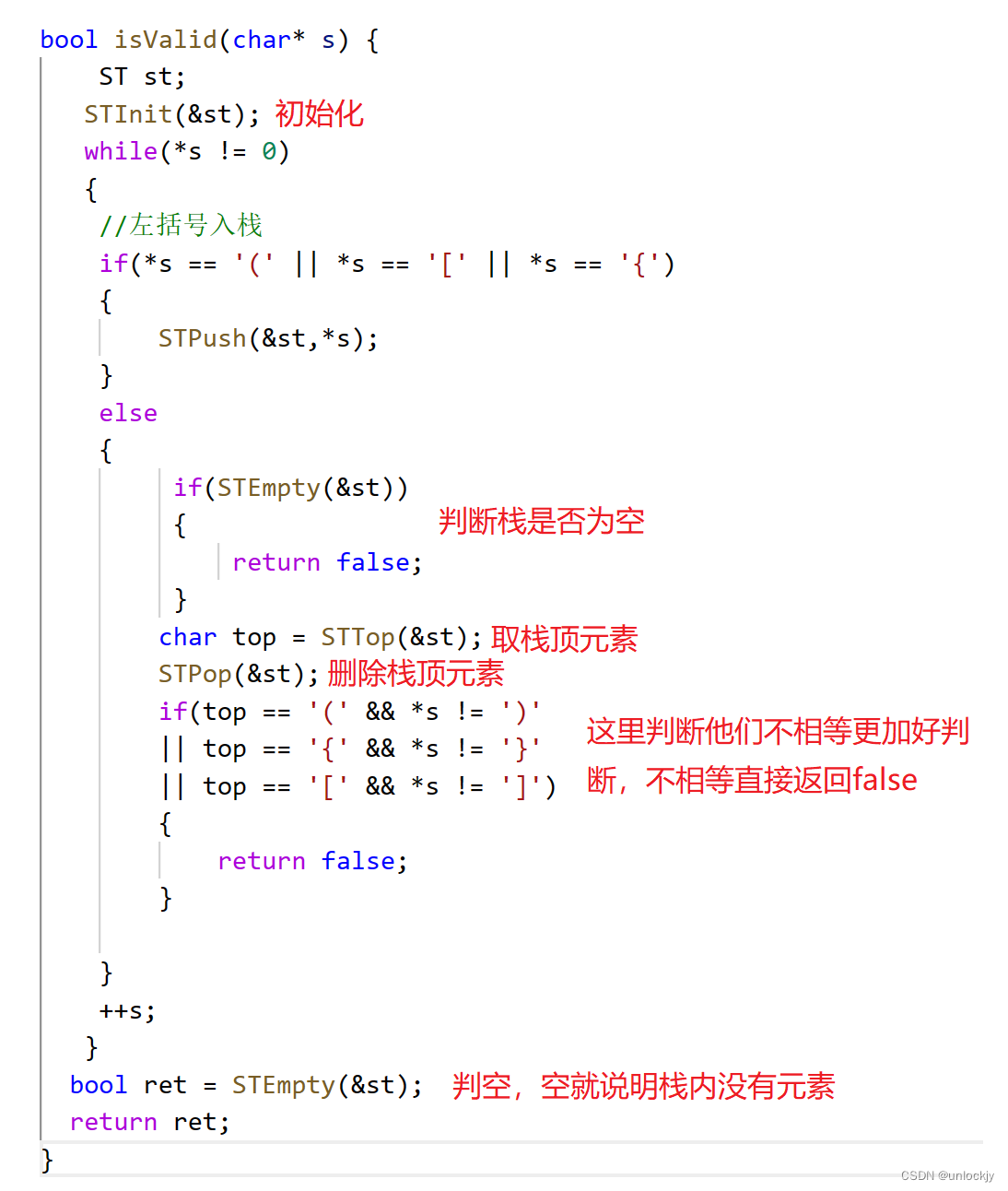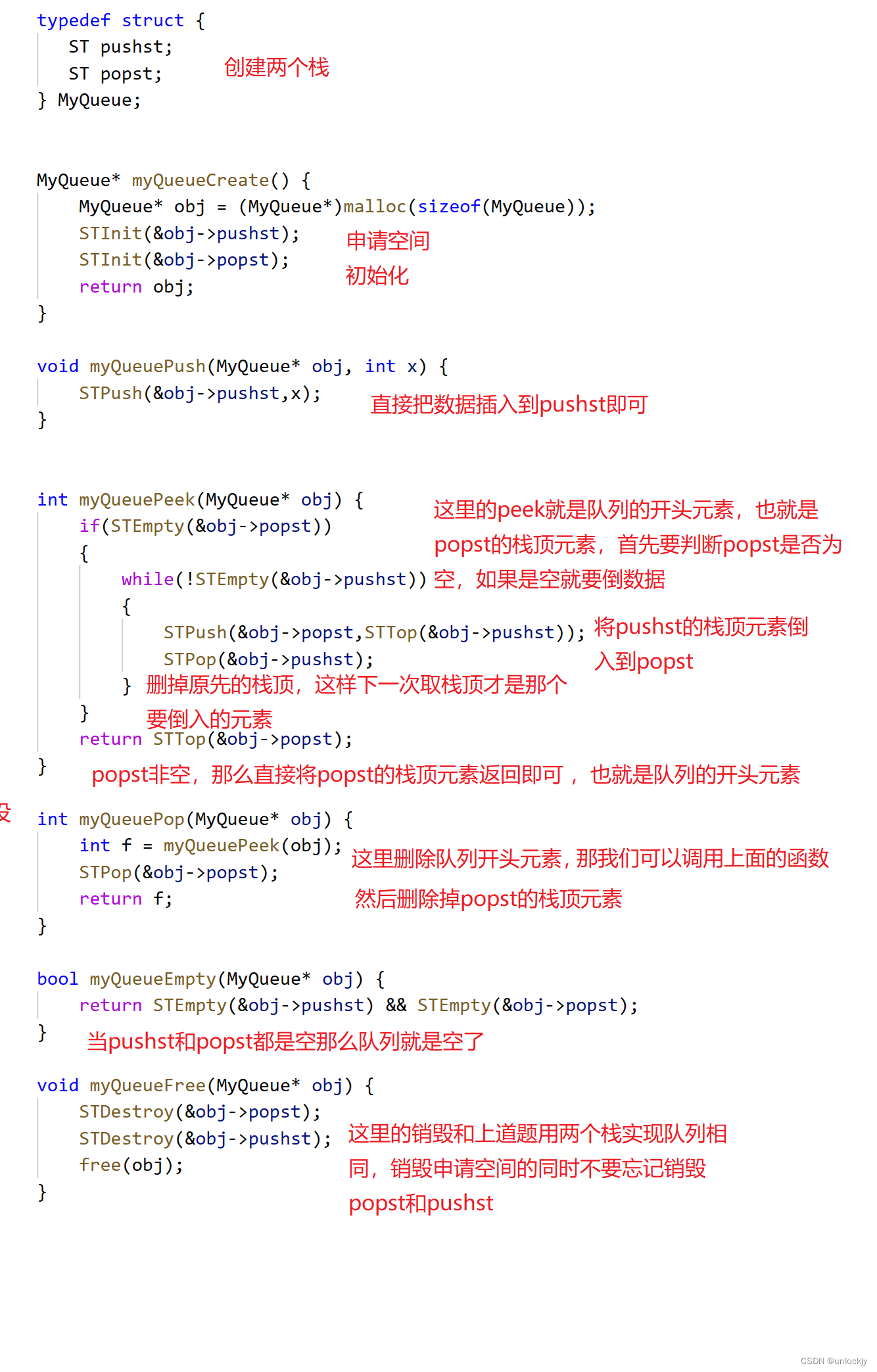1. 有效的括号 - 力扣(LeetCode)
第一题判断有效的括号,这道题我们会用到栈的知识,栈是后进先出的,可以根据这个来解这道题,先看一下题目和示例。


1.1整体思路
我们通过示例可以看出括号匹配就返回true,不匹配就返回false,这里的思路就是使用栈,如果是左括号,我们就入栈,如果是右括号,我们就取栈顶元素和右括号进行比较,如果匹配就比较下一个,不匹配直接返回false,我们可以结合图例来理解一下!
 以上是一些常见的例子,但是也有一些特殊的情况
以上是一些常见的例子,但是也有一些特殊的情况
1.']'只有一个右括号时,这个时候我们就需要加一些条件,如果栈顶没有元素,证明没有左括号入栈,那么也就是说没有左括号和右括号匹配,那就直接返回false。
2.'['只有一个括号时,那么也就是说只有左括号入栈,然后就直接返回了,这里我们可以用判断一下栈是否为空,用bool来返回,如果为空,返回true,如果不是空,证明栈里还有左括号,那也说明左括号和右扩号的数量不匹配,这样就可以有效解决了
1.2代码分析

因为还没有学C++,所以这里的栈都是自己模拟实现的
1.3整体代码
typedef char STDatatype;
typedef struct Stack
{
STDatatype* a;
int top;
int capacity;
}ST;
//函数声明
//函数的初始化和销毁
void STInit(ST* pst);
void STDestroy(ST* pst);
//进栈和出栈
void STPush(ST* pst, STDatatype x);
void STPop(ST* pst);
//栈顶
STDatatype STTop(ST* pst);
//栈是否为空
bool STEmpty(ST* pst);
//个数
int STSize(ST* pst);
//函数的初始化和销毁
void STInit(ST* pst)
{
assert(pst);
pst->a = NULL;
pst->top = pst->capacity = 0;
}
void STDestroy(ST* pst)
{
assert(pst);
free(pst->a);
pst->a = NULL;
pst->top = pst->capacity = 0;
}
//进栈和出栈
void STPush(ST* pst, STDatatype x)
{
assert(pst);
if (pst->capacity == pst->top)
{
//增加容量
int newcapacity = pst->capacity == 0 ? 4 : 2 * pst->capacity;
STDatatype* tmp = (STDatatype*)realloc(pst->a,sizeof(STDatatype)*newcapacity);
if (tmp == NULL)
{
perror("realloc");
exit(1);
}
pst->a = tmp;
pst->capacity = newcapacity;
}
pst->a[pst->top] = x;
pst->top++;
}
void STPop(ST* pst)
{
assert(pst);
assert(pst->top > 0);
pst->top--;
}
//栈顶
STDatatype STTop(ST* pst)
{
assert(pst);
assert(pst->top > 0);
return pst->a[pst->top - 1];
}
//栈是否为空
bool STEmpty(ST* pst)
{
assert(pst);
return pst->top == 0;
//等于就是空,不等于0就是非空
}
//个数
int STSize(ST* pst)
{
assert(pst);
return pst->top;
}
bool isValid(char* s) {
ST st;
STInit(&st);
while(*s != 0)
{
//左括号入栈
if(*s == '(' || *s == '[' || *s == '{')
{
STPush(&st,*s);
}
else
{
if(STEmpty(&st))
{
return false;
}
char top = STTop(&st);
STPop(&st);
if(top == '(' && *s != ')'
|| top == '{' && *s != '}'
|| top == '[' && *s != ']')
{
return false;
}
}
++s;
}
bool ret = STEmpty(&st);
return ret;
}2. 用队列实现栈
这道题是让我们用两个队列来实现一个栈,我们知道队列是先进先出的,而栈是后进先出的,那我们要如何实现呢?

2.1整体思路:
这道题的思路就是我们把要插入的数据放到那个非空的队列中,要保持一个队列是空,一个队列是非空,注意不可以两个队列都有数据,这样我们会把自己绕进去!要删除数据的时候,将非空队列的最后一个数据留下来,将其他的插入到空的队列当中,然后再将留下的那个数据删除即可。画图来理解一下


2.2 代码分析

2.3整体代码
//创建节点
typedef int QDatatype;
typedef struct Queuenode
{
QDatatype val;
struct Queuenode* next;
}Qnode;
//定义一个结构体存放指针
typedef struct Queue
{
Qnode* phead;
Qnode* ptail;
int size;
}Queue;
//队列的初始化和销毁
void QueueInit(Queue* pq);
void QueueDestory(Queue* pq);
//队列的插入和删除
void QueuePush(Queue* pq, QDatatype x);
void QueuePop(Queue* pq);
//取队列头和尾的值
QDatatype QueueFront(Queue* pq);
QDatatype QueueBank(Queue* pq);
//是否为空
bool QueueEmpty(Queue* pq);
//size
int QueueSize(Queue* pq);
//队列的初始化和销毁
void QueueInit(Queue* pq)
{
assert(pq);
pq->phead = NULL;
pq->ptail = NULL;
pq->size = 0;
}
void QueueDestory(Queue* pq)
{
assert(pq);
Qnode* cur = pq->phead;
while (cur)
{
Qnode* next = cur->next;
free(cur);
cur = next;
}
pq->phead = pq->ptail = NULL;
pq->size = 0;
}
//队列的插入和删除
void QueuePush(Queue* pq, QDatatype x)
{
assert(pq);
Qnode* newnode = (Qnode*)malloc(sizeof(Qnode));
if (newnode == NULL)
{
perror("malloc:");
exit(1);
}
//申请成功
newnode->next = NULL;
newnode->val = x;
if (pq->ptail == NULL)
{
pq->phead = pq->ptail = newnode;
}
else
{
pq->ptail->next = newnode;
pq->ptail = newnode;
}
pq->size++;
}
void QueuePop(Queue* pq)
{
assert(pq);
assert(pq->size != 0);
//一个节点
if (pq->phead == pq->ptail)
{
free(pq->phead);
pq->phead = pq->ptail = NULL;
}
else
{
//多个节点
Qnode* next = pq->phead->next;
free(pq->phead);
pq->phead = next;
}
pq->size--;
}
//取队列头和尾的值
QDatatype QueueFront(Queue* pq)
{
assert(pq);
assert(pq->phead);
return pq->phead->val;
}
QDatatype QueueBank(Queue* pq)
{
assert(pq);
assert(pq->ptail);
return pq->ptail->val;
}
//是否为空
bool QueueEmpty(Queue* pq)
{
assert(pq);
return pq->size == 0;
}
//size
int QueueSize(Queue* pq)
{
assert(pq);
return pq->size;
}
//匿名结构体
typedef struct {
Queue q1;
Queue q2;
} MyStack;
MyStack* myStackCreate() {
MyStack* obj =(MyStack*)malloc(sizeof(MyStack));
QueueInit(&(obj->q1));
QueueInit(&(obj->q2));
return obj;
}
void myStackPush(MyStack* obj, int x) {
if(!QueueEmpty(&(obj->q1)))
{
QueuePush(&(obj->q1),x);
}
else
{
QueuePush(&(obj->q2),x);
}
}
int myStackPop(MyStack* obj) {
Queue* empty = &(obj->q1);
Queue* noempty = &(obj->q2);
if(!QueueEmpty(&(obj->q1)))
{
empty = &(obj->q2);
noempty = &(obj->q1);
}
while(QueueSize(noempty) > 1)
{
QueuePush(empty,QueueFront(noempty));
QueuePop(noempty);
}
int top = QueueFront(noempty);
QueuePop(noempty);
return top;
}
int myStackTop(MyStack* obj) {
if(!QueueEmpty(&(obj->q1)))
{
return QueueBank(&(obj->q1));
}
else
{
return QueueBank(&(obj->q2));
}
}
bool myStackEmpty(MyStack* obj) {
return QueueEmpty(&(obj->q1)) && QueueEmpty(&(obj->q2));
}
void myStackFree(MyStack* obj) {
QueueDestory(&(obj->q1));
QueueDestory(&(obj->q2));
free(obj);
}
/**
* Your MyStack struct will be instantiated and called as such:
* MyStack* obj = myStackCreate();
* myStackPush(obj, x);
* int param_2 = myStackPop(obj);
* int param_3 = myStackTop(obj);
* bool param_4 = myStackEmpty(obj);
* myStackFree(obj);
*/3. 用栈实现队列
这道题是用两个栈实现队列,栈是后进先出,队列是先进先出,这个就比较好实现了

3.1整体思路
我们可以建一个pushst和一个popst,一个用来插入数据,一个用来删除数据,我们可以想一下将数据插入到pushst,栈是后进先出,那么我们将pushst的数据倒到popst,他们的顺序就发生了改变,这个时候popst栈顶的数据也就是队列第一个要出的数据,我们可以画图来看一下。这里还有一个小技巧,当popst不为空的时候,取栈顶就是队列要出的数据,这里不用来回倒,插入数据直接插入pustst即可,当popst为空时把pushst的数据都倒入到popst栈中


3.2代码分析

3.3整体代码
typedef int STDatatype;
typedef struct Stack
{
STDatatype* a;
int top;
int capacity;
}ST;
//函数声明
//函数的初始化和销毁
void STInit(ST* pst);
void STDestroy(ST* pst);
//进栈和出栈
void STPush(ST* pst, STDatatype x);
void STPop(ST* pst);
//栈顶
STDatatype STTop(ST* pst);
//栈是否为空
bool STEmpty(ST* pst);
//个数
int STSize(ST* pst);
//函数的初始化和销毁
void STInit(ST* pst)
{
assert(pst);
pst->a = NULL;
pst->top = pst->capacity = 0;
}
void STDestroy(ST* pst)
{
assert(pst);
free(pst->a);
pst->a = NULL;
pst->top = pst->capacity = 0;
}
//进栈和出栈
void STPush(ST* pst, STDatatype x)
{
assert(pst);
if (pst->capacity == pst->top)
{
//增加容量
int newcapacity = pst->capacity == 0 ? 4 : 2 * pst->capacity;
STDatatype* tmp = (STDatatype*)realloc(pst->a,sizeof(STDatatype)*newcapacity);
if (tmp == NULL)
{
perror("realloc");
exit(1);
}
pst->a = tmp;
pst->capacity = newcapacity;
}
pst->a[pst->top] = x;
pst->top++;
}
void STPop(ST* pst)
{
assert(pst);
assert(pst->top > 0);
pst->top--;
}
//栈顶
STDatatype STTop(ST* pst)
{
assert(pst);
assert(pst->top > 0);
return pst->a[pst->top - 1];
}
//栈是否为空
bool STEmpty(ST* pst)
{
assert(pst);
return pst->top == 0;
//等于就是空,不等于0就是非空
}
//个数
int STSize(ST* pst)
{
assert(pst);
return pst->top;
}
typedef struct {
ST pushst;
ST popst;
} MyQueue;
MyQueue* myQueueCreate() {
MyQueue* obj = (MyQueue*)malloc(sizeof(MyQueue));
STInit(&obj->pushst);
STInit(&obj->popst);
return obj;
}
void myQueuePush(MyQueue* obj, int x) {
STPush(&obj->pushst,x);
}
int myQueuePeek(MyQueue* obj) {
if(STEmpty(&obj->popst))
{
while(!STEmpty(&obj->pushst))
{
STPush(&obj->popst,STTop(&obj->pushst));
STPop(&obj->pushst);
}
}
return STTop(&obj->popst);
}
int myQueuePop(MyQueue* obj) {
int f = myQueuePeek(obj);
STPop(&obj->popst);
return f;
}
bool myQueueEmpty(MyQueue* obj) {
return STEmpty(&obj->pushst) && STEmpty(&obj->popst);
}
void myQueueFree(MyQueue* obj) {
STDestroy(&obj->popst);
STDestroy(&obj->pushst);
free(obj);
}
/**
* Your MyQueue struct will be instantiated and called as such:
* MyQueue* obj = myQueueCreate();
* myQueuePush(obj, x);
* int param_2 = myQueuePop(obj);
* int param_3 = myQueuePeek(obj);
* bool param_4 = myQueueEmpty(obj);
* myQueueFree(obj);
*/4.设计循环队列

这道题是让我们设计一个循环队列,队列是先进先出的,是一个循环,可以把他比较一个图书馆的桌子,有四个座位,也就是说最多可以坐四个人,如果超过四个人后面的人就要等待在坐的四个人有人坐,再坐进去,拿这个例子我们就可以很好的理解这个题目了!
4.1整体思路
这道题有多种解法,可以用链表来做,也可以用数组来做,在这里我还是用数组来做,链表比较麻烦,不论是在申请空间,还是找尾节点的前驱节点,大家感兴趣可以拿链表做一下,这里就拿数组做了,拿数组做也有出现一些小问题,如果我们只申请k个空间,那么数组是空还是满我们就分不清了,这里可以画图来看一下!

这里有两种解法,一个是定义一个计数器,还有一个是多开一个空间,就是开k+1个空间,这样我们就可以分清是空还是非空了,还有一个点就是如何让他循环起来,就是使用%,也就是每次到尾%回到下标为0的元素,这里我就采用多开一个空间的方法了,也就是%(k+1)这里画图可以帮助大家理解一下 。

这里将把每一个函数都拿出来分析!
4.2代码分析
4.2.1MyCircularQueue(k)

4.2.2isEmpty()

4.2.3isfull
 4.2.4enQueue(value)和deQueue()
4.2.4enQueue(value)和deQueue()

4.2.5Front和Rear

4.3整体代码
typedef struct {
int* a;
int head;
int tail;
int k;
} MyCircularQueue;
MyCircularQueue* myCircularQueueCreate(int k) {
MyCircularQueue* obj = (MyCircularQueue*)malloc(sizeof(MyCircularQueue));
obj->a = (int*)malloc(sizeof(int)*(k+1));
obj->head = 0;
obj->tail = 0;
obj->k = k;
return obj;
}
bool myCircularQueueIsEmpty(MyCircularQueue* obj) {
return obj->head == obj->tail;
}
bool myCircularQueueIsFull(MyCircularQueue* obj) {
return (obj->tail+1) % (obj->k+1) == obj->head;
}
bool myCircularQueueEnQueue(MyCircularQueue* obj, int value) {
if(myCircularQueueIsFull(obj))
{
return false;
}
obj->a[obj->tail] = value;
obj->tail++;
obj->tail %= (obj->k+1);
return true;
}
bool myCircularQueueDeQueue(MyCircularQueue* obj) {
if(myCircularQueueIsEmpty(obj))
{
return false;
}
obj->head++;
obj->head %= (obj->k+1);
return true;
}
int myCircularQueueFront(MyCircularQueue* obj) {
if(myCircularQueueIsEmpty(obj))
{
return -1;
}
else
return obj->a[obj->head];
}
int myCircularQueueRear(MyCircularQueue* obj) {
if(myCircularQueueIsEmpty(obj))
{
return -1;
}
else
return obj->a[(obj->tail -1 + obj->k +1) % (obj->k+1)];
//return obj->tail == 0 ? obj->a[obj->k]:obj->a[obj->tail-1];
}
void myCircularQueueFree(MyCircularQueue* obj) {
free(obj->a);
free(obj);
}
/**
* Your MyCircularQueue struct will be instantiated and called as such:
* MyCircularQueue* obj = myCircularQueueCreate(k);
* bool param_1 = myCircularQueueEnQueue(obj, value);
* bool param_2 = myCircularQueueDeQueue(obj);
* int param_3 = myCircularQueueFront(obj);
* int param_4 = myCircularQueueRear(obj);
* bool param_5 = myCircularQueueIsEmpty(obj);
* bool param_6 = myCircularQueueIsFull(obj);
* myCircularQueueFree(obj);
*/




















 496
496

 被折叠的 条评论
为什么被折叠?
被折叠的 条评论
为什么被折叠?








